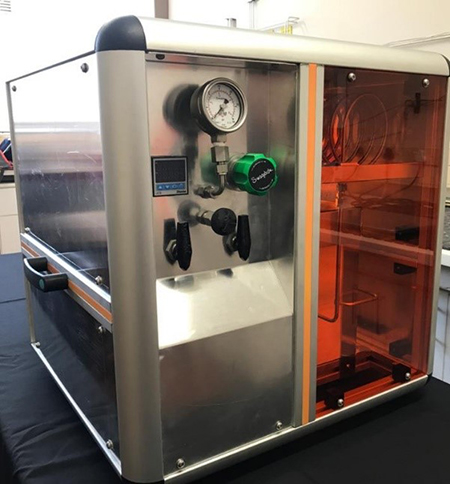In the past decade, renewable energy sources such as solar and wind have made some inroads in supplying “green” energy to the country’s power grid. To be self-sustainable with the use of renewable electricity, methods of energy storage are required, as solar and wind are naturally fluctuating and not constant sources of energy.
This is one of the research areas under investigation at the North-West University (NWU), but there is much more that solar and wind energy can do than just generate electricity, says Nicolaas Engelbrecht. He is a research engineer at the Hydrogen South Africa (HySA) Infrastructure Centre at the Potchefstroom Campus.
“Converting electrical energy into a form of chemical energy opens various avenues of producing, storing, using and trading in sustainable fuels and chemicals. One such technology pathway is using renewable energy to generate hydrogen via water electrolysis, and converting the hydrogen and waste CO2 (from any industrial process) into methane.”
Nicolaas says methane is known for its high-energy density, industrial-scale transport by ship and pipeline, its combustibility to regenerate power in gas turbines and, recently, its use as an automotive e-fuel (a fuel that is not of fossil fuel origin, and made from renewable sources).
“The fact that the synthesis of methane recycles CO2 – the primary culprit in global greenhouse gas emissions – makes this methanation process carbon neutral.”
According to him the concept of renewable energy storage is such that during a surplus of renewable electricity, methane is produced and stored. He says when the demand for electricity increases or the solar and wind potential is particularly low, methane is combusted in gas turbines to regenerate a percentage of the initial power stored (grid balancing). “Simply put, this process is a chemical battery with megawatt-scale potential.”
Converting hydrogen and CO2 into methane
HySA Infrastructure is an NWU-hosted research entity that is directed by Prof Dmitri Bessarabov, and focuses on the associated infrastructure for hydrogen production, storage and distribution.
A methanation technology demonstrator was recently developed, built and tested at HySA. The core of the demonstrator features a micro-engineered reactor that supports the catalytic reaction of hydrogen and CO2 into methane.
The reactor was built in collaboration with the German Fraunhofer IMM research institute.
“The reactor contains 1 800 microchannels which support heat and mass transfer properties that are not typically achievable with conventional reactor technologies,” says Nicolaas.
The reactor has a dual purpose as a heat exchanger, as during the methanation process about 18% of the total chemical energy is converted into heat, which is recoverable for use elsewhere.
Nicolaas says although the methanation process has been demonstrated at laboratory scale only, a processing capacity of close to 1 kilowatt (kW) was achieved at an overall efficiency of up to 76%.
“This efficiency is deemed high considering the size of the reactor investigated here. The production of methane is therefore a viable method of storing renewable energy in a chemical form for various end-uses.”
Other multifaceted research is under way at HySA Infrastructure, such as the conversion of a significant portion of 55 kW photovoltaic sun energy into renewable hydrogen at the NWU’s Faculty of Engineering.
The facility has a hydrogen storage capacity in the order of 4,5 megawatt-hours (MWh). The energy park also supports the storage of hydrogen in other chemicals such as long-chain organic molecules with significant hydrogen storage capability (LOHCs), and in the future, there are plans to investigate ammonia for hydrogen storage as an equally promising technology route.
Nicolaas says HySA Infrastructure is further active in postgraduate student training, research publication and attracting third-party and international funding towards the NWU.
“Other currently active projects include the purification of typical industrial and hydrogen-containing gas streams, hydrogen compression via electrochemical methods, the flameless combustion of hydrogen for high-quality heating, as well as safety applications, and an extensive project portfolio on high energy density LOHCs.”
Recent scientific publications related to this article:
N Engelbrecht, RC Everson, D Bessarabov. 2020. Thermal management and methanation performance of a microchannel-based Sabatier reactor/heat exchanger utilising renewable hydrogen. Fuel Processing Technology, 208:106508. https://doi.org/10.1016/j.fuproc.2020.106508
M du Toit, N Engelbrecht, SP Oelofse, D Bessarabov. 2020. Performance evaluation and emissions reduction of a micro gas turbine via the co-combustion of H2/CH4/CO2 fuel blends. Sustainable Energy Technologies and Assessments, 39:100718. https://doi.org/10.1016/j.seta.2020.100718

HySA’s renewable hydrogen-to-methane demonstrator.

Nicolaas Engelbrecht, a research engineer at HySA, says there is a lot of potential for solar and wind energy beyond just electricity.
